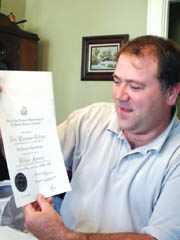Although interested in his family history, Tim Griffith of Secaucus hadn’t gone to Cambria County, Penn., searching out the roots of his family. He had gone there on an assignment as a property assessor and arrived at the county seat a little early.
“It was lunch time and the people I needed to see weren’t going to be around for a couple of hours,” he said, recalling his trip there during the summer. “I’ve always been interested in my family history. But I never did much about it.”
Griffith new some of his family had come from that part of the country, so on a whim, he called his mother to find out where, learning to his surprise he was at the right place.
This was the county seat at Ebensburg. This was coal mining country, and that part of his family had come to America from coal mining country in Great Britain.
Some of the towns his family originated in had ceased to exist, such as Barnsboro and Spangler – both long ago incorporated into north Cambria. He found small signs indicating their location, but little more.
“I knew my grandmother came from the area,” he said. “I tried to find my grandmother’s birth certificate.”
Griffith knew part of his family was distantly related to President Martin Van Buren and that some of his family members had also come over on the Mayflower, but he was curious to follow the threads of this branch of his family. So he went down to the county clerk to ask for information.
His mother gave him a couple of last names to work with, maiden names that might be helpful in finding records during his brief search, such as Wadell and Westover.
The news seemed bad when he began his search, since the clerk there informed him that many of the county’s earlier records were no longer kept on file in that office. Everything previous to 1906 had been relocated. He knew his grandmother was born in 1910, so he asked to see his great grandparents’ marriage certificate since they were married in the area in 1906. It bore a small nugget of real news, since the document not only contained his grandparents’ names but the names of their parents as well.
“It showed what my great grandparents did, where they were married,” he said. “His occupation was listed as a miner. He was 39 and a widower. She was 26.”
He had hit pay dirt, but he did not yet know how significant this was until – with his appetite whetted for more information — he walked a block to the local historical society and asked for information about the families on the certificate. Wadell yielded nothing. But the historical society had a file on Westover an inch thick.
“I went into their conference room with the file and opened it up,” he said. “There on top was a certificate from the Order of the Crown of Charlemagne in the United States” awarded to a woman named Fern Westover Coliver and a file of records that proved a direct connection between her and the Emperor of France.
Griffith was stunned. But he grew more stunned as he went through the records that showed his branch of the family connected to the trunk of this family tree, and that Fern Coliver had tracked and recorded the blow-by-blow history of family members all the way back in time.
“She had done all the research,” Griffith said. “She listed where the records could be found.”
The list in front of him listed the exact location the original records could be found in county seats and libraries on both sides of the Atlantic, each generation dutifully accounted for – taking Griffith back along the route his ancestors had taken to get to Pennsylvania, back to Massachusetts and Connecticut, where one relation was mentioned in the dictionary of The First Settlers in New England.
The trail soon took Griffith across the Atlantic to England, where he discovered his relations to landed gentry listed as “Gentlemen,” Esquires,” “Lords” and eventually “Knights.” One distant relation along this line was the Earl of Somerset, whose father had apparently died in Jerusalem during the Crusades in October, 1193.
But the trail did not stop there. It crossed the English channel to a fractured Europe, where family members ruled some of the tiny, no longer existing nations that made up parts of the Hapsburg Empire. Family members came from countries like Alost and Luxembourg. One was listed as Count of Verdun. The documents tracked Griffith’s family line back to Louis II of France in 844, and before him Charles II, and finally Louis I, Charlemagne’s son.
Although Griffith still has to check out all of the references, the documents the historical society and the names he had from his mother match up.
“I’m stunned,” Griffith said. “I never imagined I would come up with anything like this.”
